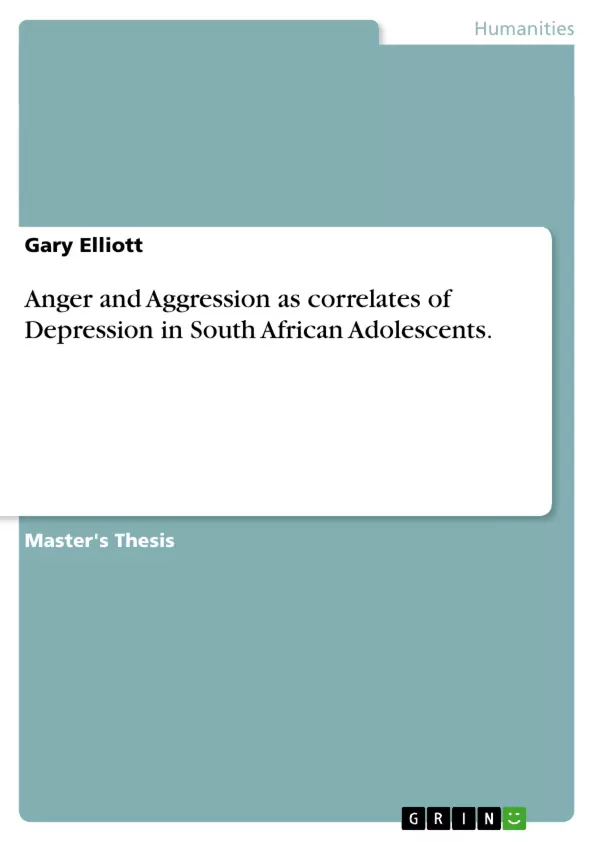The primary objective for this study was to conduct an empirical investigation to gather information in the form of data from adolescent males and females in the Pretoria region of South Africa. Information was gathered with respects to their level of physical aggression, verbal aggression, anger, hostility and depression. The information was used to identify whether correlations exist between the three variables anger, aggression and depression for South African adolescents.
A literature study was conducted and the following hypotheses were developed for this study:
I. Males are more likely to engage in physical aggression than females.
II. Males and females are equally likely to engage in verbal aggression.
III. Males are more likely to experience feelings of anger towards others.
IV. Females are more likely to experience feelings of hostility towards others.
V. Males and females are equally likely to report feelings of depression.
VI. Rates of physical aggression are higher in younger adolescent males than older adolescent males.
VII. The expressions of verbal aggression in females are constant throughout adolescence.
VIII. There is a significant positive correlation between feelings of anger and expressions of aggression.
IX. There is a significant positive correlation between feelings of anger and feelings of depression.
X. There is a significant negative correlation between physical aggression and feelings of depression.
The quantitative data gathered came from the completion of a structured questionnaire comprising four distinct sections: demographic information, the Buss-Perry Aggression Questionnaire (BPAQ), the Anger Questionnaire (AQ) and the Choate Depression Inventory for Children (CDIC). The questionnaire was administered to Grade 7-12 pupils (aged 12-19 years old) in an independent school in Pretoria. The sample group was randomly selected and yielded 243 completed questionnaires. The data was coded and entered into the Moon Stats statistical programme for analysis; affording the opportunity to generate both univariate and bivariate statistics in conjunction with the calculation of Pearson product moment correlations.
Analysis of the data yielded the following results:
More males than females recorded ‘medium’ levels of physical aggression at 58% to 42% respectively; this trend remains for ‘high’ levels on this section, with males recording 66% against 34% for females.
Inhaltsverzeichnis (Table of Contents)
- Introduction
- Literature Review
- Theories of Anger and Aggression
- Theories of Depression
- The Relationship between Anger, Aggression and Depression
- Methodology
- Participants
- Measures
- Procedure
- Data Analysis
- Results
- Descriptive Statistics
- Correlational Analysis
- Discussion
- Limitations of the Study
- Implications for Future Research
- Conclusion
Zielsetzung und Themenschwerpunkte (Objectives and Key Themes)
This study aimed to explore the relationship between anger, aggression, and depression in South African adolescents. The research utilized a quantitative approach to analyze data gathered from a sample of adolescents in Pretoria, South Africa. Key themes investigated include:- Gender differences in anger, aggression, and depression.
- The relationship between anger and aggression.
- The relationship between anger and depression.
- The relationship between aggression and depression.
- The influence of age on levels of anger, aggression, and depression.
Zusammenfassung der Kapitel (Chapter Summaries)
The introduction provides a background to the study, outlining the objectives, research questions, and hypotheses. The literature review presents a comprehensive overview of theoretical frameworks and empirical studies related to anger, aggression, and depression, focusing on the existing research regarding the relationship between these constructs, particularly within the context of adolescence. The methodology section details the procedures employed in the study, including participant recruitment, data collection methods, and the measures used to assess anger, aggression, and depression. The results chapter presents the statistical analysis of the gathered data, exploring both descriptive statistics and correlational analyses to investigate the relationships between the variables of interest.Schlüsselwörter (Keywords)
The primary focus of this study is on the relationships between anger, aggression, and depression in South African adolescents. The study investigates gender differences, age-related trends, and the correlational associations between these constructs. Key terms include anger, aggression, depression, adolescence, South Africa, gender differences, and correlational analysis.- Quote paper
- Gary Elliott (Author), 2013, Anger and Aggression as correlates of Depression in South African Adolescents., Munich, GRIN Verlag, https://www.grin.com/document/233568



